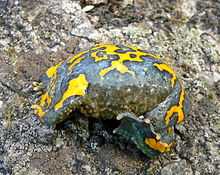Unkenreflex


Unkenreflex – interchangeably referred to as unken reflex – is a defensive posture adopted by several branches of the amphibian class – including, but not exclusive to, salamanders, toads, and certain species of frogs.[1] Implemented most often in the face of an imminent attack by a predator, unkenreflex is characterized by the subject’s contortion or arching of its body to reveal previously hidden bright colors of the ventral side, tail, or inner limb; the subject remains immobile while in unkenreflex.[2]
During the course of unkenreflex, the amphibian in question will release toxins from its parotid glands, tense its entire body, and swallow air to bloat itself in an attempt to look larger.[3] These secretions, along with the aposematic coloring that is common among the amphibians who display unkenreflex, serve as a warning to nearby predators that the amphibian in question may be poisonous.[4]
Not all amphibians who display unkenreflex possess aposematic coloring nor do all amphibians display unkenreflex to the same degree.[5] Certain species of anurans, such as the adult male Rana macrocnemis, only half-complete unkenreflex by only twisting their body slightly and not revealing their entire underside coloring.[6] This half completion of unkenreflex can be found in both species who display aposematic coloring as well as those who do not; Unken reflex is not entirely limited to poisonous amphibians.[7]
This behavior is named after the Fire-bellied toad (German: Unke; combining form: Unken-) which exhibits this reflex.
References
- ↑ Carretero, M. A., Sillero, N., Corti, C., Jorge, F., Freitas, S., & Arakelyan, M. (2011). Unkenreflex in Rana macrocnemis from Armenia. Herpetology Notes, 67-69.
- ↑ Pröhl, H., & Ostrowski, T. (2011). Behavioural elements reflect phenotypic colour divergence in a poison frog. Evolutionary Ecology, 993-1015.
- ↑ Harkewicz, K. A. (2004). Maintenance of bombina species of frogs. Seminars in Avian and Exotic Pet Medicine, 229-233.
- ↑ Gohli, J., & Högstedt, G. (2010). Reliability in Aposematic Signaling: Thoughts on evolution and aposematic life. Communicative & Integrative Biology, 9-11.
- ↑ Pröhl, H., & Ostrowski, T. (2011). Behavioural elements reflect phenotypic colour divergence in a poison frog. Evolutionary Ecology, 993-1015.
- ↑ Carretero, M. A., Sillero, N., Corti, C., Jorge, F., Freitas, S., & Arakelyan, M. (2011). Unkenreflex in Rana macrocnemis from Armenia. Herpetology Notes, 67-69.
- ↑ Brodie, Edmund (1989), Venomous Animals: 300 Animals in Full Color, Western Publishing, ISBN 0-307-24074-6.
| ||||||||